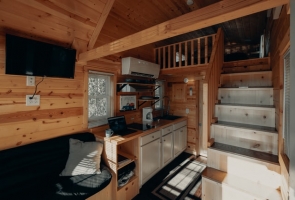One of the more popular emerging real estate marketing subjects in recent years has been the concept of tiny homes. Millennials and Gen-Zers are looking for places they can call theirs that don’t carry a lot of overhead or extra bills. Tiny homes are a thing of interest for minimalist lifestyles as well.
Of course, these aren’t the only groups you could be targeting. If you have your strategy established already and just need to know how to organize your content, keep reading. This is what we’re here to discuss today.
Since my business is content creation, I want to look at this subject from a real estate content marketing point of view and show you how a well-organized written content strategy can help you meet your goals. Now, when some business owners hear the phrase “content marketing,” they think in terms of bloggers trying to earn money on the concept, but that’s only one subsection of content marketers. If you are a realtor, broker, or manufacturer of tiny homes, you can, and should, be developing a solid content marketing strategy that involves all the steps I’m about to outline for you.
Know Your Purpose and Target Audience
Are you a manufacturer or affiliate selling tiny home plans? Are you a realtor who specializes in tiny home sales and small space brokering? What are your conversion goals? All of these things need to be clearly defined before you even start planning your content strategy.
Developing an ideal avatar or buyer persona is a good way to help define precisely how to target your marketing. If this is something you haven’t delved into before, I highly recommend clicking the link in this paragraph and learning what you can about the process.
Secure Your Domain
Your tiny home marketing content needs a place to live, and that place should be a branded, unique domain that identifies your brand or business well. I suggest looking at a variety of keyword lists and deciding on a domain name that reflects what people search when they’re looking for tiny houses. Of course, the answer to that question will depend primarily on the purpose of your marketing efforts and who your target reader and potential customer happen to be.
Once you have that established, plug in some keywords that reflect your business, target demographic, and the kinds of conversions you’re looking to achieve. Terms like “tiny home-buying millennials” will help you narrow down a few key terms that you can use to decide on a domain name and the metadata terms that will help the right target audience to find you when you seed your content with them.
Develop an Optimized Website
I think this really goes without saying, or it should. I still see plenty of sites that just don’t show up right on my phone, and that is a huge problem. Responsiveness is a key factor in how Google ranks websites. If you’re just starting out, it’s probably a given that your web designer will have this detail covered, but if your site has been out there for a while – even just a year or a little more – you might want to have a look and see if there are any ways you can enhance the end-user experience. If you haven’t done any major overhauls to your site in over five years, no one is finding you. Go ahead, check the numbers and tell me I’m wrong.
Start Creating Content
With an arsenal of keywords at your disposal, start organizing a content creation and publishing schedule. You’ll want to start with at least five blog posts at launch and well-organized social media and email campaigns that let people know you’re out there. Invest in social media ads that target the right users (your ideal avatar should make them easy to identify) and look into successful PPC/CPC options with a proven track record of reaching targeted users with proficiency.
You’ll want to develop copy for your ads with variants that allow for split-testing. I recommend starting with at least five ad copy variants per ad and narrowing it down to the ones that get the best response. This really is online marketing 101. But knowing how so many marketers actually approach this process, this friendly reminder seems appropriate. Split test, crunch the numbers, and zero in on your real demo.
Steer Away From Features and Benefits
Most people who are researching tiny homes already know what the features and benefits are – maximizing lifestyle with minimal space and clutter is the most common reason people choose tiny houses, even over cost.
Drive the lifestyle aspects and the innovations that go into the design and appointments of tiny homes. Develop content that gets people excited about making a tiny house a home. How does it feel to live in a tiny house? How do well-designed tiny homes maximize living space? These are the kinds of questions that your content should be addressing.
Steer away from topics like “10 reasons to buy a tiny house.” Anyone who finds your content already has their reasons. Instead, gravitate toward things like “10 ways to beautify outdoor space around your tiny home” or “Popular multifunctional appointments for your tiny home.” Those two ideas are free. Want more? We have more. Contact us.
Write For the Conversions You Want
Finally, you want your content to get the results you’re aiming for, so make sure you know what your ultimate goals are. Are you trying to sell or rent? Are you trying to sell specific fixtures or enhancements? Are you targeting singles or couples? These and many other considerations also need to be ironed out before you ever start writing.
The focus of your content matters. Don’t expect brand visibility alone to get the results you want. Remember, most people will never take any action on your content without being asked. Develop calls to action that complement the content you produce and make sure the CTAs you tag onto your content are relevant and likely to get results.
Quality Content Creation Services
BeezContent has extensive experience delivering quality content on a wide range of real estate topics. If you need help developing a solid written content strategy, contact us for a little help and advice. We are the team you need at launch to help ensure the fast discovery and success of your written content. Contact us to find out how we can assist with your real estate content creation needs.




